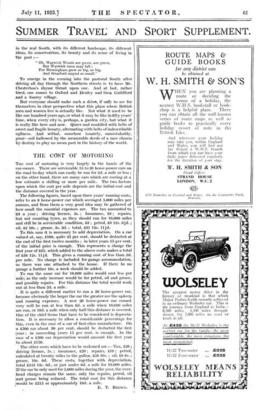MOTORING THROUGH ENGLAND
A MODERN motor-car certainly does make it seem rather small.' You can drive from one end of England and Scotland to the other in two summer days. And, though personally I think it is rather far for pleasure, it may be worth doing so for the sake of a sort of perspective bird's-eye view of the island.
-Mr. C. E. Montague has an essay in which he picks out six high points, each in sight of the next, from which on the perfect day you can see the whole of England. From them, he says, you can get the real idea of the island as a whole, its construction, the basic architecture of highland and lowland on which it has been built. You see and recognize the outline of coast which you know on the map, but transfigured into reality. And you realize in a second something you could not get from a map in half a year. " The Throne of Kings" seems suddenly more than a phrase, and you see England, as it were, face to face.
Motoring fairly fast from one end of the island to the other gives one almost the same sensation. Although you do not see so much of it at any one moment as from the hilltops, yet you see it steadily unrolling itself before you like a great carpet. And if in the car you lose something of the structural architecture of hill and valley you gain a knowledge of the surface, the actual texture, of the landscape which you get from no hilltop. You may not see " the Coloured Counties "' stretched below you as from Bredon. But you do experience one after another the peculiar individual flavour of each. Each has its own peculiar place names, each its own kind of landscape, its characteristic building stone, its pasture or its plough. And some are still counties of the traditional England of " meadow, stream and hill," while others are scarred and seared beyond recognition by coal- getting or machine-making. And you see how the country fades suddenly before industrialism or the fields hold out pathetically amongst the factories. On the drive I am thinking of we started in Moray, near Elgin, and our destination was the borders of Surrey and Sussex. We started out through that curious rich, almost flat Morayshire country. It seems very un-English, with its straight roads and its fertile, carefully- cultivated fields—like a cool, clear-aired, flatter Normandy. And the names are all very Highland and Celtic, Dava, Craigellachie, Kingussie. Then the road leads up into the high, wide splendid moorland—why in the name of wonder are these treeless solitudes called forests ?—of the Grampians. Fine, rolling, curving roads with easy gradients, to be taken at a steady forty-five or fifty m.p.h. Down the other side to Blair Atholl with its castle, and Aberfeldy with its tweed shop. (We visited the latter.) On, right through the middle of Perthshire, this seems the very core and heart of Scotland ; and so to Stirling. And then, suddenly, after Stirling, the landscape becomes dotted with little upright towers in the distance, and then little round things like wheels in the air, and you are amongst the mines and the factories. You are into the Scottish industrial belt. For twenty miles there is no more country. Only a succession of long dreary mining villages. The children are all outside playing in what are half roads, half streets. And then suddenly you hear a curious clatter, clatter, and turning a corner, under a railway arch perhaps, you find the road filled with a hundred or so stooping, dark figures, hurrying along in a strange, even half walk, half trot. They scarcely lift their faces, black as any negro's, as the car passes. The miners are going home ; an impressive sight that somehow makes you catch your breath. And then out again into rolling lowland country. To Gretna and the border—to Ecclefechan where a supposed signpost to Carlisle turned out to be a direction to Thomas Carlyle's cottage (Strange to think of the little places nurturing the farouche genius.) So to Carlisle itself, and on to Keswick, for the night.. Next morning is sweet with the tender Lake Country. At Lancaster, and then at Preston, industrialism again. -
" The Dark Satanic Mills " are with us now, almost, I had said, right through to Birmingham. But that is the end of them. Birmingham is, I always think, the great southern bastion of industrial England. After it we are immediately
e E
in the real South, with its different landscape, its different ideas, its conservatism, its beauty and its sense of living in the past :— " Oh, Warwick Woods are green, are green, But Warwick trees may fall ; For Birmingham grew so big, so big, And Stratford stayed so small."
To emerge in the evening into the pastoral South after driving all day through the Northern streets is to have Mr.
Chesterton's rhyme thrust upon one. And at last, rather tired, one comes to Oxford and Henley and then Guildford and a Surrey village.
But everyone should make such a drive, if only to see for themselves in clear perspective what this place where British men and women live is actually like. Not what it used to be like one hundred years ago, or what it may be like in fifty years' time, when every city is, perhaps, a garden city, but what it is really like here and now. Queer and muddled with belts of :sweet and fragile beauty, alternating with belts of indescribable iugliness. And withal, somehow innately, unmistakably,
great—soil hallowed by the memorable deeds of a race chosen by destiny to play no mean part in the history of the world.



























































 Previous page
Previous page